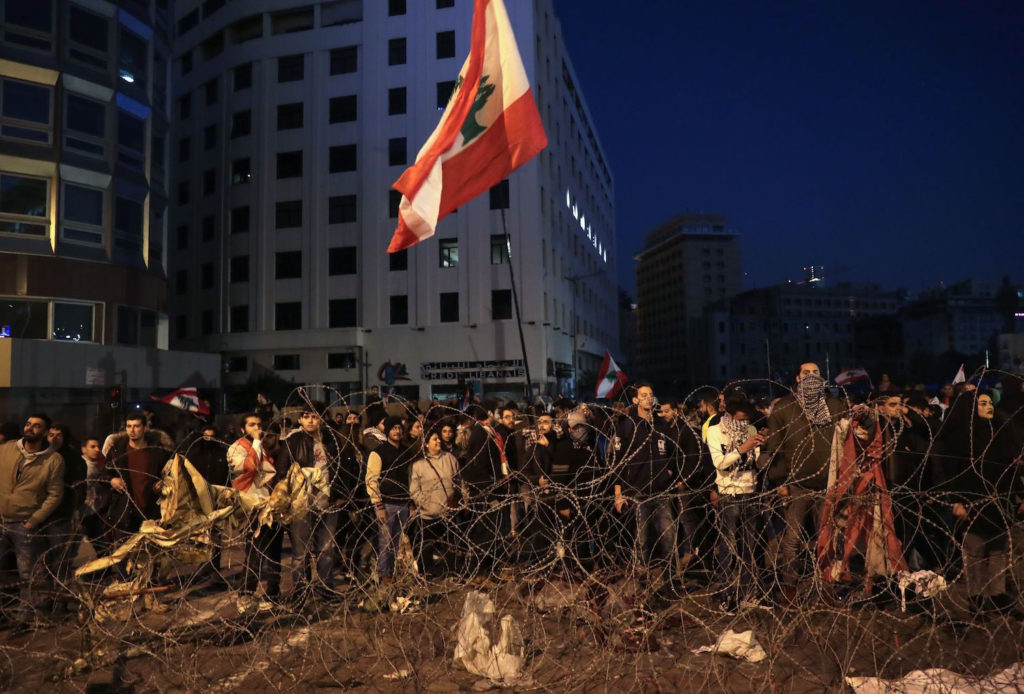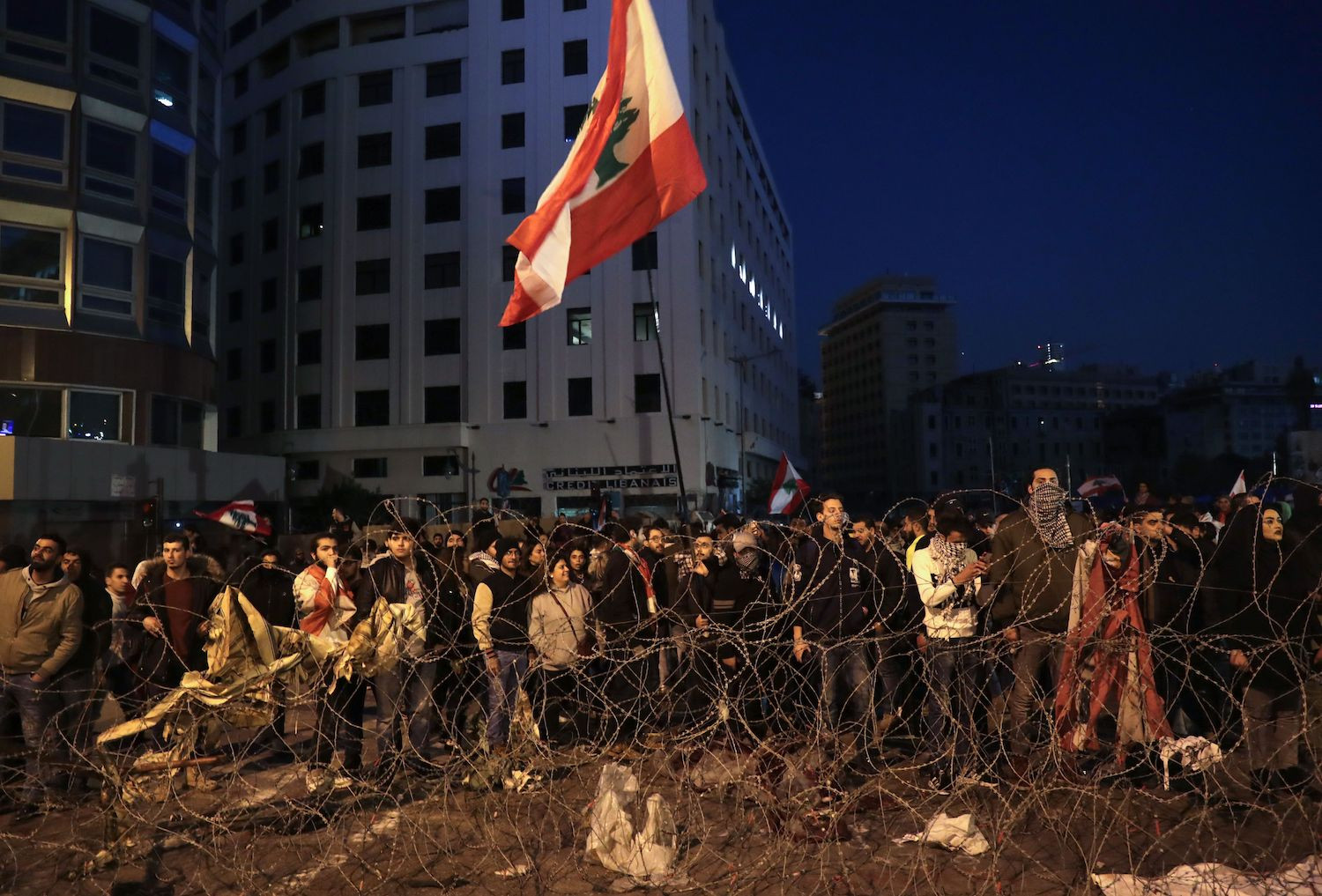The only political system the country has ever known is collapsing, and it’s never coming back.

What does it look like when a state collapses? It is a question that analysts ask ever more often about the Middle East, where five states are currently in some form of existential crisis. Yet one of these states stands apart. Yemen, Syria, Iraq, and Libya have recently gone through uprisings, civil war, external interventions, and regional proxy fights. Lebanon’s crisis, by contrast, is self-inflected—and that makes it far more hopeless.
It’s true that Lebanon does not have full sovereignty and is an arena of Israeli-Iranian and Saudi-Iranian competition, but these problems are not the proximate cause of the country’s present troubles. What’s happening in Lebanon is the death spiral of the country’s post-civil war order.
Nobody—least of all the Lebanese themselves—knows what comes next
For those not paying attention, here is the story in brief: Years of dysfunction and corruption have finally caught up with Lebanon’s political class, which thrived on both, bankrupting the country in the process. The first hints of this emerged in early 2019 when the Banque du Liban—Lebanon’s central bank—mandated that money transfers from abroad conducted through nonbanking institutions such as Western Union be denominated in lira even if the transfer indicated that the transaction was to be done in dollars. In subsequent weeks and months, the demand for dollars increased, but to maintain the illusion of currency stability, Lebanese central bank authorities maintained the currency peg of 1,507 lira to the dollar. Then the law of supply and demand took over, resulting in a black market in dollars and the further deterioration in the value of the lira. Fitch Rating then downgraded Lebanon’s credit from B- to CCC, which is an indication that—to Fitch, at least—Lebanon was at risk of default. In September 2019, Jammal Trust Bank liquidated after being hit with U.S. sanctions over its relationship with Hezbollah. This bank was not a huge player, but its closure further eroded trust in the financial services sector. A few weeks later, the government slapped a 20-cent daily tax on WhatsApp calls. This desperate attempt to raise revenue led to protests that continued throughout last fall and winter, to which the government had no response.
Since then, the full extent of Lebanon’s economic problems has come into view. Lebanon does not produce much; the country imports 80 percent of what it needs, including food and fuel. Its economy is based on real estate, banking, and transfers from the Lebanese diaspora. Banks have offered high interest rates to attract dollar deposits, which bankers then lent to the government. This was not a great way to run a financial system, but it functioned so long as the inflow of dollars continued. Yet when the inflows fell and the government—bereft of revenue—could not pay the banks back, the system collapsed. In March, Lebanon defaulted on its debt, proving Fitch correct.
The lira has lost 85 percent of its value, a significant hardship on people under any circumstances, but it is a situation that is made far worse by the coronavirus pandemic. Like most of the rest of the world, Lebanon shut down to try to break the chain of infection and save people’s lives. Yet the country does not have much in the way of a social safety net, and the growing ranks of unemployed are now confronting crushing inflation. This is a situation in which no one is spared except for the wealthy. Lebanon’s downward mobility has sped up since the October 2019 protests, with more than half the population now in poverty or destitute. Not surprisingly, food insecurity is on the rise, bartering is becoming a way of life for some, there is little electricity, and those who can are leaving for Canada and Europe. The desperation is such that there has been a spate of suicides on Lebanon’s streets this summer.
And what is the Lebanese government doing to manage the crisis? Fighting reform, bickering with parliament, resisting the International Monetary Fund, and flirting with China—all in what seems to be a vainglorious hope that small Lebanon is actually too big to fail. It isn’t. The professional staff at the IMF should get credit for their tenacity in trying to help the Lebanese, especially because there is not a lot of international enthusiasm to help the government out of its mess. The French foreign minister showed up in Beirut recently, but only to reinforce the message that reform is of the essence. In Washington, those who don’t want to bail out a government and political class that are compromised by Hezbollah have thus far won the argument. Neither the Saudis nor the Emiratis are inclined to help. The Qataris have not stepped up. That leaves the Chinese as the remaining possible patron, but once the Lebanese government signs up with Beijing that means there is no going back. Given the current state of U.S.-Chinese relations and Washington’s influence at the IMF, officials in Beirut should not expect much from the fund if they take the Chinese deal.
The dysfunction and blame-shifting within the political class are hard to bear as the country collapses around them. It is, however, what the political system has wrought, which is why the millions of Lebanese who turned out in the streets last fall want to tear it all down. Lebanon has long featured a system that by convention divvied up power and state resources along religious lines. Most famously, the president is always a Christian, the prime minister a Sunni, and speaker of the parliament a Shiite. The Chamber of Deputies—the parliament—is, in accordance with Lebanon’s constitution, split evenly between Christians and Muslims and proportional to various sects. The system is a legacy of French colonial rule, which sought to maintain social peace in a country with multiple sectarian divisions. But over time this system became baked into Lebanon’s social and economic order. Even after the 1975-1990 civil war, during which there was sectarian bloodletting, Lebanon went back to this formula.
But it is dubious that the system has maintained internal peace in recent times. To the extent that the country has recently been stable, that has more likely been a function of the inclusion in government of the outright militarized sectarian Shiite group Hezbollah. But even if to the extent that Lebanon’s efforts to create stability through some semblance of orderly and agreed-upon distribution of sectarian power worked, it has also bred remarkable amounts of corruption. In the early 2000s, officials acknowledged the need to get beyond sectarian politics, but it was lip service. Positions continue to be doled out based on religious affiliation, and are state resources, which are in turn cycled through networks of other officials, bureaucrats, and supportive business interests at the expense of the greater good. It creates constituencies and groups of officials who are on the take and who grew richer, more powerful, and more voracious all at the expense of average Lebanese. No one should be surprised by the country’s battered infrastructure and virtually nonexistent government services. This is what an arrogant, wasteful political class looks like.
The protesters who turned out en masse last fall knew what Lebanon needs: a whole new system. It must be one that does away with political and financial spoils based on sect in favor of a more equitable and just order. It was hard not to admire the determination and creativity with which the Lebanese sought this change, but despite their best efforts, they remained saddled with a political class for which maintaining the current system is existential. This is setting the country up for prolonged suffering as its leaders try desperately to outmaneuver their own moral and financial bankruptcy. That is what collapse looks like.
FOREIGN POLICY

Leave a Reply
You must be logged in to post a comment.